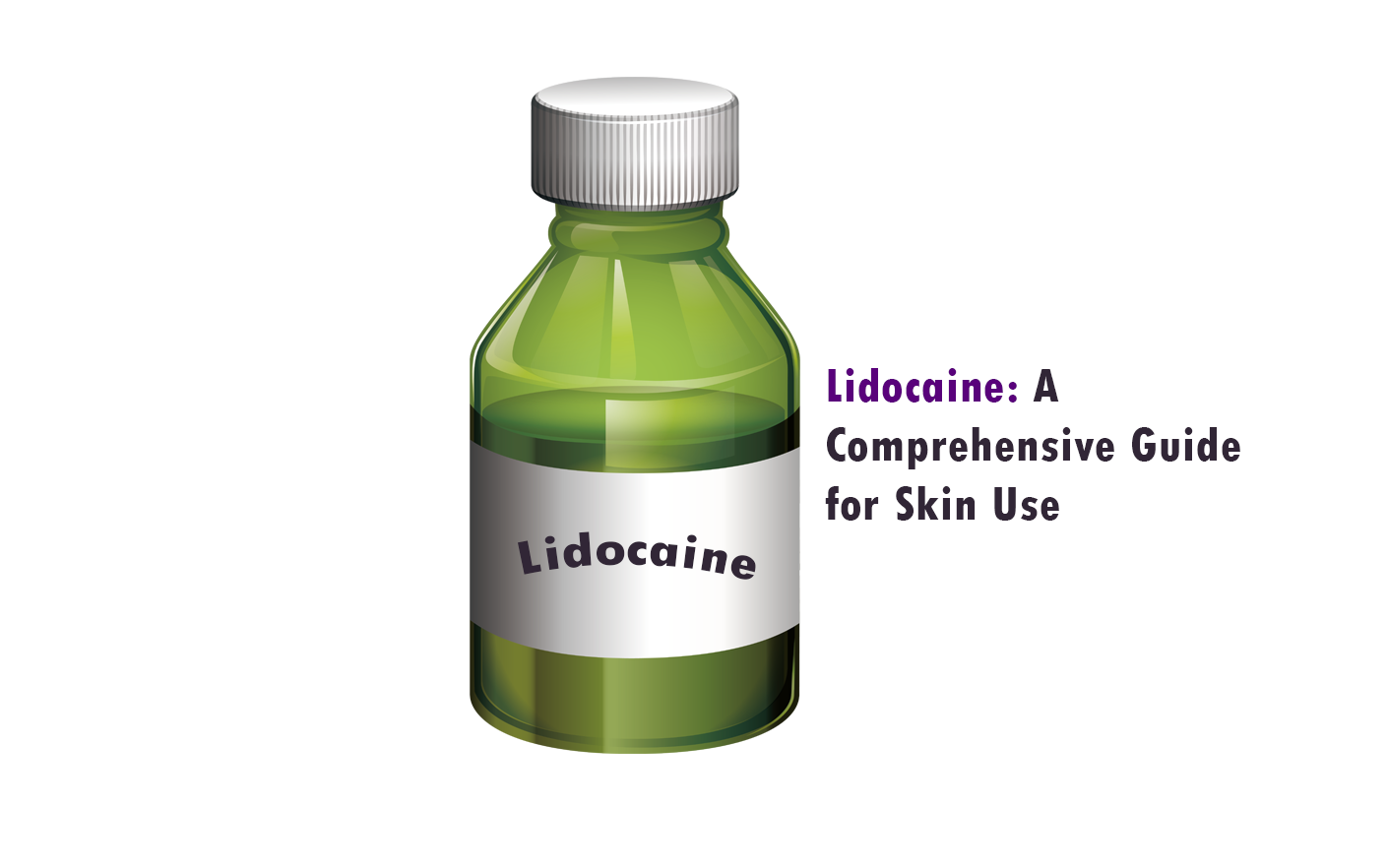
Lidocaine: A Comprehensive Guide for Skin Use
Lidocaine is a widely used local anesthetic that temporarily numbs the skin and mucous membranes. It is commonly found in topical creams, gels, sprays, and injectable forms for medical and cosmetic procedures. In this blog, we’ll explore how lidocaine works, its benefits, side effects, natural alternatives, usage guidelines, limitations, and FDA-approved limits.
What Is Lidocaine?
Lidocaine belongs to the amide class of anesthetics and works by blocking sodium channels in nerve cells, preventing them from sending pain signals to the brain. It is used for:
- Medical procedures (minor surgeries, injections, IV insertions)
- Dermatological treatments (laser hair removal, microneedling, tattoo removal)
- Pain relief (sunburn, insect bites, shingles, eczema)
- Cosmetic applications (dermal fillers, Botox, waxing)
How Does Lidocaine Work on the Skin?
When applied topically, lidocaine penetrates the skin’s outer layers and binds to nerve endings, temporarily inhibiting pain signals. The effects typically begin within:
- 2–5 minutes (for fast-acting formulations like sprays)
- 20–30 minutes (for creams and gels)
- Lasts 30 minutes to 3 hours, depending on concentration and application method.
Benefits of Lidocaine for Skin
- ✅ Pain Relief – Numbs skin before injections, waxing, or laser treatments.
- ✅ Reduces Discomfort – Helps with burns, rashes, and post-procedure soreness.
- ✅ Non-Invasive – Topical application avoids systemic side effects (unlike oral painkillers).
- ✅ Widely Available – Sold over-the-counter (OTC) in lower concentrations (2–5%) and by prescription for higher doses.
Side Effects & Risks
While lidocaine is generally safe, improper use can cause:
- Redness, itching, or swelling at the application site
- Temporary numbness beyond the target area
- Dizziness, confusion, or blurred vision (if absorbed into the bloodstream)
- Irregular heartbeat or seizures (in extreme cases of overdose)
- Allergic reactions (hives, difficulty breathing) – Seek emergency help if this occurs.
⚠️ Mild Reactions:
⚠️ Serious Side Effects (Rare, but possible with overuse or allergies):
Who Should Avoid Lidocaine?
- People with lidocaine allergies or heart conditions
- Pregnant or breastfeeding women (unless approved by a doctor)
- Children under 12 (unless under medical supervision)
Natural Alternatives to Lidocaine
For those seeking non-chemical options, consider:
- 🌿 Clove Oil (contains eugenol, a natural anesthetic)
- 🌿 Peppermint Oil (cooling effect, mild numbing)
- 🌿 Aloe Vera Gel (soothes burns and irritation)
- 🌿 Chamomile Extract (anti-inflammatory and calming)
Note: Natural alternatives are milder and may not provide the same level of numbing as lidocaine.
How to Use Lidocaine Safely
- Patch Test First – Apply a small amount to check for allergies.
- Clean & Dry Skin – Ensure the area is free from cuts or infections.
- Apply a Thin Layer – Use the recommended amount (avoid excessive use).
- Wait for Full Effect – Usually 20–30 minutes before procedures.
- Do Not Cover with Bandages (unless directed) – Occlusion increases absorption and risk of side effects.
- Wash Off After Use – Once numbness is no longer needed, remove residue.
Limitations of Lidocaine
- Not for Deep Pain – Only numbs surface-level nerves.
- Short Duration – Effects wear off within hours.
- Variable Absorption – Thicker skin (like palms) may resist penetration.
- Risk of Overuse – Applying too much can lead to systemic toxicity.
FDA-Approved Limits for Lidocaine
- OTC Topical Products: Up to 4% concentration (e.g., creams, sprays).
- Prescription Strengths: Up to 5% (lidocaine patches, such as Lidoderm).
- Healthy Adults: No more than 300 mg per application (or 4.5 mg/kg body weight).
- Children: Must be carefully dosed by a doctor.
Maximum Dosage:
Exceeding these limits increases the risk of lidocaine toxicity, which can affect the heart and nervous system.
Conclusion:
Lidocaine is a powerful and effective numbing agent for skin-related pain, but it must be used responsibly. Always follow FDA guidelines, perform a patch test, and consult a doctor if you have concerns. For those preferring natural options, clove oil and aloe vera can offer mild relief, though they may not match lidocaine’s strength.
Important Notice: The information provided in this article is for educational and informational purposes only and is not intended as a substitute for professional medical advice, diagnosis, or treatment. Always consult a qualified healthcare provider before using lidocaine or any other medication, especially if you:
- Have allergies, heart conditions, or are pregnant/breastfeeding.
- Are taking other medications (to avoid interactions).
- Are treating children, elderly individuals, or those with sensitive skin.
- Research Limitations: While studies on parabens are ongoing, this article reflects current knowledge as of its publication date.
- Follow FDA-approved guidelines and product instructions carefully.
- Overuse or improper application of lidocaine can lead to serious side effects, including toxicity.
- Discontinue use and seek medical help if you experience rash, dizziness, irregular heartbeat, or difficulty breathing.
⚠️ Warning:
Disclosure: As an Amazon Associate, We earn from qualifying purchases. Product prices and availability are accurate as of the date/time indicated and are subject to change.
Lactic Acid
HERE
LEAVE A REPLY
Your email address will not be published. Required fields are marked *
Fast Delivery
Across West & East India
safe payment
100% Secure Payment
Online Discount
Add Multi-buy Discount
Help Center
Dedicated 24/7 Support
Curated items
From Handpicked Sellers





LEAVE A COMMENTs
Suzanna Jack
"Wow, this is the most detailed guide on lidocaine I’ve ever read! I had no idea about the FDA limits or natural alternatives. Bookmarking this for my next laser appointment—thanks for the safety tips!"
Yeni Andriani
"Great article, but I’m worried about toxicity. My doctor prescribed lidocaine for nerve pain, and I accidentally used too much last week. Your side effects section convinced me to call them ASAP. Maybe add a bold warning about overuse?"
Mia Thomas
"Used lidocaine before microneedling at home—BIG mistake. Numbed too deep and bled more than usual. Your ‘limitations’ section explained why. Stick to pros, folks!"